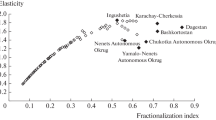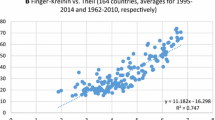Abstract
Well-specified property rightsenhance economic performance but vary considerably across countries.The failure of numerous nation-states to adopt growth-enhancinginstitutions is paradoxical. This paper examines the role ofethnic and linguistic diversity in retarding the developmentof growth-enhancing property rights and in-turn economic growth.The data show that property rights are attenuated in more diversepolities and economic growth is correspondingly lower.
Similar content being viewed by others
References
Alchian, A. A. (1977) “Some Economics of Property Rights. ” In Economic Forces at Work. Indianapolis: Liberty Press.
Alesina, A., and Spolaore, E. (1997) “On the Number and Size of Nations. ” Quarterly Journal of Economics 12: 1029–56.
Anderson, T. L., and Hill, P. J. (1975) “The Evolution of Property Rights: A Study of the American West. ” Journal of Law and Economics 18: 163–179.
Bailey, M. J. (1992) “Approximate Optimality of Aboriginal Property Rights. ” Journal of Law and Economics 35: 183–98.
Barrett, D. B. (1982) World Christian Encyclopedia. Nairobi: Oxford University Press.
Barro, R. J. (1991) “Economic Growth in a Cross Section of Countries. ” Quarterly Journal of Economics 106: 407–43.
Barro, R. J. (1996) Getting It Right. Cambridge, Mass.: MIT Press.
Barro, R. J., and Sala-I-Martin, X. (1995) Economic Growth. New York: McGraw-Hill.
Barro, R. J. (1999) “Determinants of Democracy. ” Journal of Political Economy 107: S158–83.
Baumol, W. J. (1994) “Multivariate Growth Patterns: Contagion and Common Forces as Possible Sources of Convergence. ” In: Baumol, W. J., Nelson, R. R., and Wolf, E. N. (eds) Convergence in Productivity. New York: Oxford University Press.
Benson, B. L. (1990) The Enterprise of the Law: Justice without the State. San Francisco: Pacific Research Institute.
Bolton, P., and Roland, G. (1997) “The Breakup of Nations: A Political Economy Analysis. ” Quarterly Journal of Economics 112: 1057–90.
Calabresi, G., and Malamed, A. D. (1972) “Property Rules, Liability Rules and Inalienability: One View of the Cathedral. ” Harvard Law Review 85: 1089–1128.
Coase, R. H. (1960) “The Problem of Social Cost. ” Journal of Law and Economics 3: 1–44.
Coase, R. H. (1988) The Firm, the Market and the Law. Chicago: University of Chicago Press.
Collier, P. (1998) “The Political Economy of Ethnicity. ” World Bank, Washington, D.C.
Collier, P., and Gunning, J. W. (1999) “Explaining African Economic Performance. ” Journal of Economic Literature 37: 64–111.
Dawson, J. W. (1998) “Institutions, Investment and Economic Growth. ” Economic Inquiry 36: 603–19.
Demsetz, H. (1964) “The Exchange and Enforcement of Property Rights. ” Journal of Law and Economics 7: 11–26.
Demsetz, H. (1967) “Toward a Theory of Property Rights. ” American Economic Review 57: 347–59.
Easterly, W., and Levine, R. (1997) “Africa's Growth Tragedy. ” Quarterly Journal of Economics 112: 1201–50.
Eggertsson, T. E. (1990) Economic Behavior and Institutions. Cambridge: Cambridge University Press.
Ellickson, R. C. (1991) Order without Law: How Neighbors Settle Disputes. Cambridge, MA. Harvard University Press.
Friedman, D. (1977) “A Theory of the Size and Shape of Nations. ” Journal of Political Economy 85: 59–77.
Gastil, R. (1987) Freedom in the World. Westport, CN: Greenwood Press.
Gellner, E. (1983) Nations and Nationalism. Ithaca, N.Y.: Cornell University Press.
Grief, A. (1989) “Reputation and Coalitions in Medieval Trade: Maghribi Traders. ” Journal of Economic History 59: 857–882.
Gwartney, J., Lawson, R., and Block, W. (1996) Economic Freedom in the World. Vancouver, B.C.: Fraser Institute.
Gwartney, J., and Lawson, R. (1997) Economic Freedom in the World. Vancouver, B.C.: Fraser Institute.
Hirsch, E. D. (1987) Cultural Literacy. Boston: Houghton Mifflin.
Holmes, K. R., Johnson, B. T., and Kirkpatrick. (1997) Index of Economic Freedom. Washington, D.C.: The Heritage Foundation and New York: The Wall Street Journal.
Horowitz, D. L. (1987) Ethnic Groups in Conflict. Berkeley, CA: University of California Press.
Isaacs, H. R. (1989) Idols of the Tribe: Group Identity and Political Change. Cambridge, Mass.: Harvard University Press.
Katz, M., and Shapiro, C. (1994) “System Competition and Network Effects. ” Journal of Economic Perspectives 8: 93–115.
Keefer, P., and Knack, S. (1997) “Why Don't Poor Countries Catch-Up? A Cross-National Test of an Institutional Explanation. ” Economic Inquiry 35: 590–602
Kimenyi, M. S. (1997) Ethnic Diversity, Liberty and State: The African Dilemma. Northampton, MA.: Edward Elgar.
Knack, S. (1996) “Institutions and the Convergence Hypothesis: The Cross-National Evidence. ” Public Choice 87: 207–28.
Knack, S., and Keefer, P. (1995) “Institutions and Economic Performance: Cross-Country Tests Using Alternative Institutional Measures. ” Economics & Politics 7: 207–27.
Knack, S., and Keefer, P. (1997) “Does Social Capital Have an Economic Payoff? A Cross-Country Investigation. ” Quarterly Journal of Economics 112: 1251–87.
Landa, J. T. (1994) Trust, Ethnicity and Identity. Ann Arbor: University of Michigan Press.
La Porta, R., Lopez-de-Silanes, F., Shleifer, A., and Vishny, R. (1999) “The Quality of Government. ” Journal of Law, Economics and Organization 15: 222–270.
Lazear, E. P. (1995) “ Culture and Language. ” NBER Working Paper 5249.
Lazear, E. P. (1999) “Culture and Language. ” Journal of Political Economy 107: S95-S126.
Lian, B., and Oneal, J. (1998) “Cultural Diversity and Economic Development: A Cross-National Study of 98 Countries. ” Economic Development and Cultural Change 46: 61–77.
Mankiw, N. G., Romer, D., and Weil, D. N. (1992) “A Contribution to the Empirics of Growth. ” Quarterly Journal of Economics 107: 407–37.
Muller, S. H. (1964) The World's Living Languages: Basic Facts of Their Structure, Kinship, Location, and Number of Speakers. New York: Ungar.
Munro, D. (1996) The Oxford Dictionary of the World. Oxford: Oxford University Press.
North, D. C. (1981) Structure and Change in Economic History. New York: W.W. Norton.
North, D. C. (1990) Institutions, Institutional Change and Economic Performance. Cambridge: Cambridge University Press.
Olson, M. (1965) The Logic of Collective Action. Cambridge, MA: Harvard University Press.
Olson, M. (1996) “Big Bills Left on the Sidewalk: Why Some Nations Are Rich and Others Poor?" Journal of Economic Perspectives 10: 3–24.
Ostrom, E., Gardner, R., and Walker, J. (1994) Rules, Games and Common Pool Resources. Ann Arbor: University of Michigan Press.
Political Risk Services. (1991) International Country Risk Guide. East Syracuse, N.Y.
Sachs, J. (1997) “The Limits of Convergence. ” The Economist 17: 19–22.
Sachs, J., and Warner, A. (1997) “Fundamental Sources of Long-Run Growth. ” American Economic Review 87: 184–88.
Sandler, T. (1992) Collective Action. Ann Arbor: University of Michigan Press.
Scully, G. W. (1988) “The Institutional Framework and Economic Development. ” Journal of Political Economy 96: 652–62.
Scully, G. W. (1992) Constitutional Environments and Economic Growth. Princeton: Princeton University Press.
Smith, V. K. (1992) “Economic Principles in the Emergence of Humankind. ” Economic Inquiry 30: 1–13.
Sowell, T. (1994) Race and Culture. New York: Basic Books.
Taylor, C. L., and Hudson, M. C. (1972) World Handbook of Political and Social Indicators (2nd ed.). New Haven, CN: Yale University Press.
Tornell, A., and Lane, P. R. (1999) “The Voracity Effect. ” American Economic Review 89: 22–46.
White, H. (1980) “A Heteroscedasticity-Consistent Covariance Matrix and a Direct Test for Heteroscedasticity. ” Econometrica 48: 817–38.
World Bank. (1997) World Development Indicators. Washington, D.C.
Author information
Authors and Affiliations
Rights and permissions
About this article
Cite this article
Norton, S.W. The Cost of Diversity: Endogenous Property Rights and Growth. Constitutional Political Economy 11, 319–337 (2000). https://doi.org/10.1023/A:1026567305485
Issue Date:
DOI: https://doi.org/10.1023/A:1026567305485




